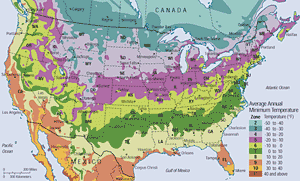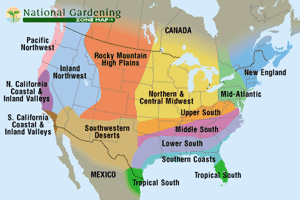
The United States has an enormous range of climate conditions. In some areas there is heat and drought. In others the climate is described as "nine months of winter and three months of poor sledding."
Yet, there are active gardeners everywhere, successfully working in harmony with nature.
In most of the country, the outdoor gardening season gets into full swing just after the last frost of spring, and ends with the first frost of fall.
That window of time--the outdoor growing season--is the basis for when and what vegetable and annuals you plant. It is a critical factor in your garden planning. These two dates should be recorded in your garden planning notebook.
You probably have a general idea of when it comes, but you can find the annual average frost dates from several sources. One is the Cooperative Extension Service at your state university. Another is the weatherman at your local television station. See the National Gardening Regional Report for your region to learn more.
For gardeners growing long-lived plants that must survive winter, the United States has been divided up into climate zones on special maps created by the United States Department of Agriculture. Called the USDA Zone Map, the zones show annual, average minimum temperatures that gardeners living in them can expect. Most catalogs and books contain these maps, and plant descriptions will identify what zones are best for each plant. You can see the USDA Zone Map at the National Gardening Regional Report.

National Gardening has created its own system of 14 "gardening zones." Rather than minimum temperature alone, these regions are defined by largely similar gardening conditions. Expert gardeners in each region report on conditions and happenings in their region twice monthly. Click here to see these National Gardening Zones, their descriptions, and the reports.
In areas where drought is a recurrent problem, people have turned to an idea called "xeriscaping." This calls for using only plants that are native to the area, or those that have shown they can survive the local conditions without excessive watering. In many areas, garden watering is often restricted by local or state regulations.
In cold winter areas, everyone cheats a little bit to stretch the season. Plants are grown indoors in greenhouses to be well on their way when the last frost has passed. Many experienced gardeners start their own plants from seed to save money, grow hard-to-find varieties, and get started gardening while the snow is still deep on the ground. A crowd of seedlings on a sunny windowsill makes it seem that spring is around the corner.
Before setting these plants out into the garden, remember that they have been grown under perfect conditions and are not adapted to the harsh outside world of direct sun, wind, and wide shifts in temperature. They can suffer "transplant shock."
To avoid this shock, "harden them off" for several days before planting. Set them out in their containers for a half a day and then bring them indoors. Gradually lengthen the time outdoors. Keep them well watered.
Vegetable gardeners get a jump on the season by planting certain seeds in the garden two weeks before the last frost of spring. Among the seeds that can be planted before the last frost are peas, lettuce, onion sets, spinach, garlic, cabbage, potatoes, and radishes.